German infantry anti-tank weapons (part 2)
Soon after the German attack on the Soviet Union, it became clear that the anti-tank rifles at the disposal of the Wehrmacht were limitedly effective against light tanks and absolutely unsuitable for fighting medium T-34 and heavy HF. In this regard, the German infantry, as during the First World War, was forced to use improvised means: bundles of grenades, engineering checkers with explosives and mines. In bundles, 5-7 Stielhandgranate 24 (M-24) grenade cases were usually used, attached to a grenade with a handle using a waist belt, wire or rope. Moreover, each grenade contained 180 g of explosives, most often the “mallet” was equipped with surrogates based on ammonium nitrate.
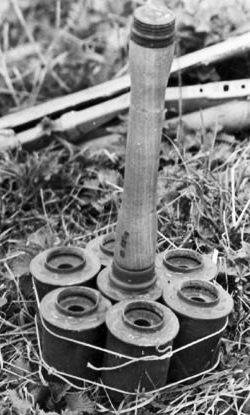
According to German instructions, it was recommended to throw a bunch of grenades under the undercarriage, or, jumping onto the tank, to lay it under the aft niche of the tank tower, after which to activate the grating fuse. It is clear that this method of destruction of armored vehicles was extremely risky for someone who dared to do this.
Similarly, but much less frequently, TNT and Melinite 100-200 g checkers were used against tanks, combined into bundles of 5-10 pieces and equipped with a rope loop or wooden handle, as well as 1 kg of Sprengbüchse 24 engineering ammunition (using handles (Sprengbüchse 1924) (also with a wooden handle) of the year). It could be thrown at a distance of up to 20 m using the handle on the outside of the waterproof box.
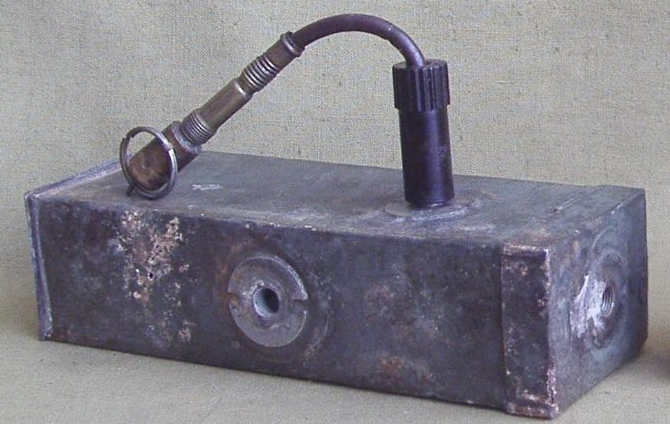
German engineering ammunition Sprengbüchse 24 with a detonator installed in the socket, equipped with an igniter cord and an ignitor ANZ-29
Sprengbüchse 24 was a piece of explosive (TNT or picric acid) in a waterproof zinc or steel container with a carrying handle and three holes for detonators. In the case of use as a hand-held anti-tank bomb, standard ANZ-10 ignitors were used to ignite a non-conducting cord of length 15-29 mm. Also 1 kg charges when installing pressure fuse DZ-35 could be enclosed under the tracks of the tanks.
In addition to their own grenades and engineering ammunition, the German infantry used the captured Soviet RGD-33 grenades, which in the initial period of the war captured more than 300 thousand units, for the manufacture of anti-tank bunches. RGD-33 was adopted by the Wehrmacht under the designation Handgranate 337 (r) and was actively used until the 1943 year. In addition, the Germans did not shy away from using incendiary bottles on the Eastern front, although of course on a smaller scale than in the Red Army.
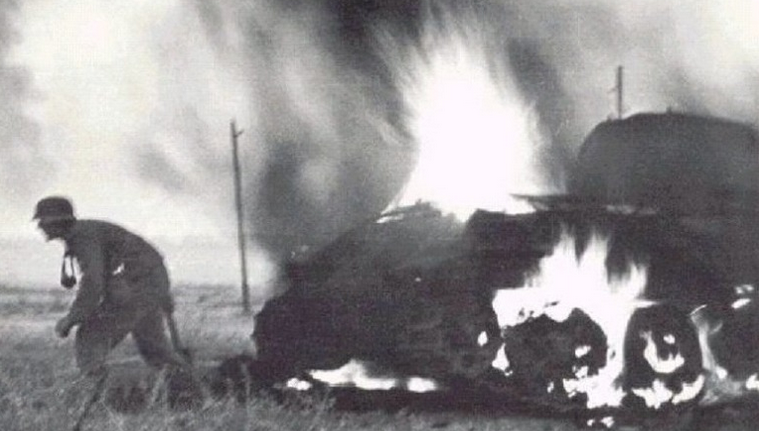
As for anti-tank mines, they were used rather limitedly in the initial period of the war. However, it was envisaged that the Tellermine 35 anti-tank mines (T.Mi.35) with a push action fuse could be dragged under the chassis of tanks moving perpendicular to fire cells and trenches of infantrymen with the help of a rope or telephone wire.
To combat armored vehicles and long-term gun emplacements in Germany at the end of 30, a cumulative Panzerhandmine mine (German Anti-tank anti-tank mine) was designed, which was attached to the armor with a felt pad soaked in a sticky compound. During storage and transportation, the adhesive surface was covered with a protective cover.
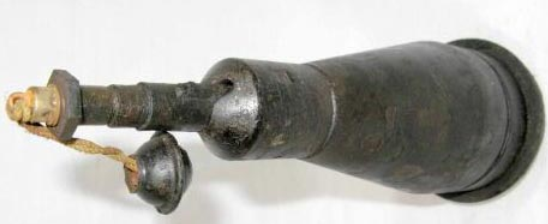
The 430 g of a mixture of TNT and ammonium nitrate and a tetrile detonator of 205 g were contained inside the 15 g mines. The main charge had a cumulative funnel with steel lining and was able to penetrate the 50 mm normal armor. Panzerhandmine was packaged with a standard grater fuse from a hand grenade, with a delay time of 4,5-7. Theoretically, the mine could have been thrown at the target as a hand grenade, but there was no guarantee that it would hit the target with its head and stick to the armor.
The real experience of the fighting demonstrated the lack of armor penetration of the sticky mine and the impossibility of fixing it on a dusty or damp surface. In this regard, at the beginning of 1942, a more sophisticated bottle-shaped Panzerhandmine 3 (PHM 3) with an aluminum alloy body was adopted.
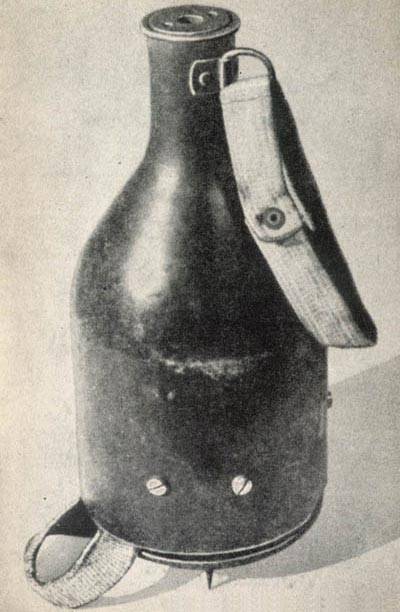
Unlike the earlier model, this ammunition was mounted on armor with the help of magnets. In addition, Panzerhandmine 3 was additionally supplied with a metal ring with studs for attaching mines to a wooden surface. On the "neck" of the mine there was a cloth loop for suspension on the belt. Panzerhandmine 3 was equipped with a standard grating fuse and a detonator cap from an Eihandgranaten 39 (M-39) hand grenade with 7 deceleration. Compared with the “sticky mine”, the magnetic mine became much heavier, its weight reached 3 kg, and the mass of explosive was 1000 g. At the same time, the armor penetration increased to 120 mm, which already allowed punching frontal armor of heavy tanks.
Soon, the magnetic form of a bottle-shaped mine in production was replaced by a mine, known as Hafthohlladung 3 or HHL 3 (it. Attached shaped charge). With armor penetration increased to 140 mm, this ammunition was simpler and cheaper to manufacture.
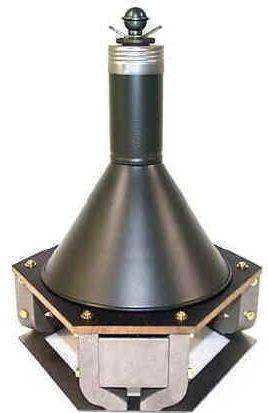
The hull of the mine was a tin funnel with a handle attached to a getinkax plate, to the bottom of which three powerful magnets were attached, which were closed with a safety ring during transportation. In preparation for combat use in the handle placed a fuse from a hand grenade with a slowdown 4,5-7 with. Magnets withstand force in 40 kg. The mass of the mine itself was 3 kg, of which half fell on explosives.
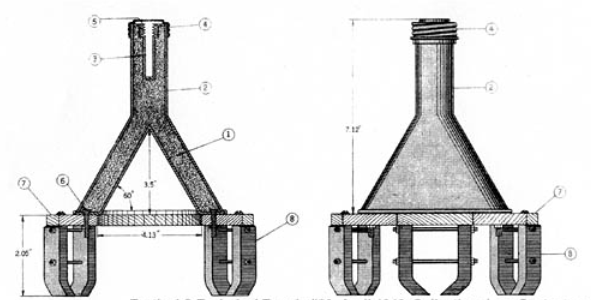
1 - Explosive. 2 - Handle. 3 - Detonator socket. 4 - Thread for fuse fuse. 5 - Location of the fuse. 6 - Magnet mounting bolts. 7 - Getenax plate. 8 - Magnets.
In the middle of 1943, an improved Hafthohlladung 5 (HHL 5) appeared. Changes made to the form of a cumulative funnel and an increase in the mass of the explosive to 1700 g allowed punching 150-mm armor or 500 mm of concrete. In this case, the mass of the upgraded mines amounted to 3,5 kg.
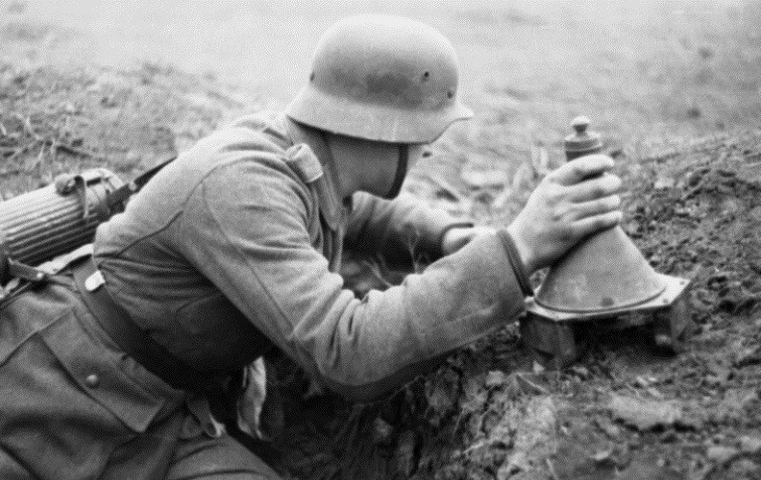
A sufficiently high armor penetration and the ability to install on armor at a right angle, regardless of the shape of the armor case, made it possible to overcome the protection of any Soviet tank used during the Second World War. However, in practice, the use of HHL 3 / 5 was difficult and associated with greater risk.
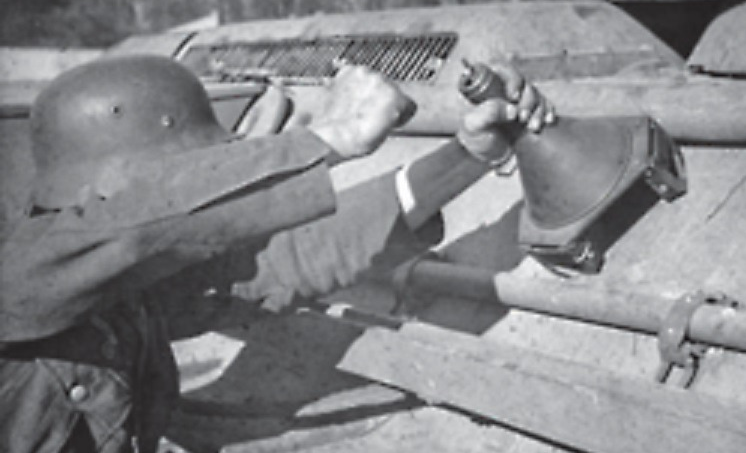
In order to fix the magnetic mine in vulnerable places of the moving armored vehicles, it was required to leave the trench or another shelter and get close to the tank closely, and after placing the mine on the armor to initiate the fuse. Taking into account the fact that the zone of continuous destruction by shrapnel during the explosion was approximately 10 m, there were few chances of surviving a fighter tank. The infantryman at the same time required tremendous courage and readiness for self-sacrifice. The opportunity to install a mine without exposing itself to mortal danger, the German soldier had only on the ground with shelter, during the fighting in the city or against a tank that had lost mobility and was not covered by its infantry. However, magnetic mines were produced in significant quantities. In 1942-1944 More than 550 thous. HHL 3 / 5 cumulative ammunition was produced, which was used in combat until the last days of the war.
In addition to anti-tank magnetic mines in service with the German infantry, there were cumulative hand grenades Panzerwurfmine 1-L (PWM 1-L). Literally, the name of the grenade can be translated as: Hand-held anti-tank mine. This ammunition in 1943 was created by order of the Luftwaffe to arm paratroopers, but was later actively used by the Wehrmacht.
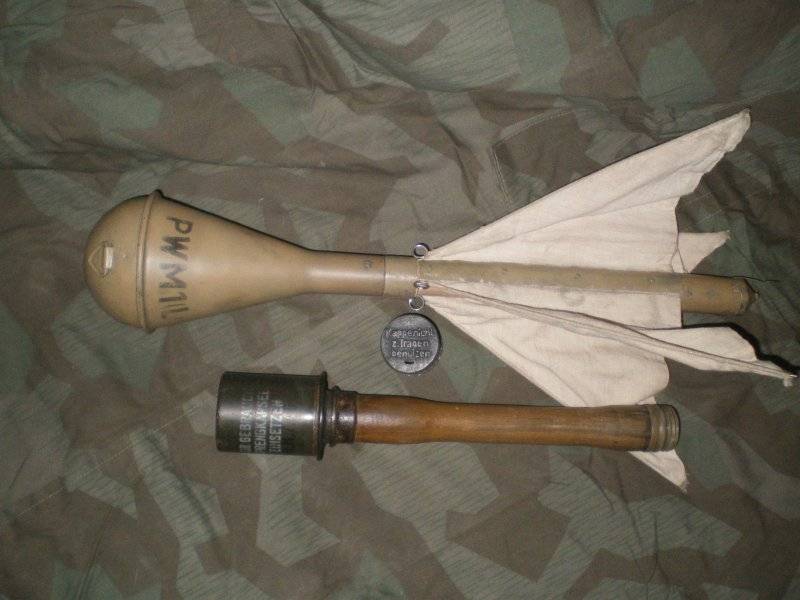
Cumulative Panzerwurfmine 1-L Grenade near Stielhandgranate 24 frag grenade
The grenade had a drop-shaped tin body to which a wooden handle was attached. On the handle was placed a spring-loaded stabilizer made of cloth that opens after removing the safety cap during the throw. One of the stabilizer springs translated an inertial fuse into a firing position. A grenade weighing 1,4 kg was loaded with 525 g of an alloy of trotyl with RDX and at an angle of 60 ° could penetrate 130 mm armor; when meeting with armor at right angles, armor penetration was 150 mm. After the impact of the cumulative jet, a hole with a diameter of about 30 mm was formed in the armor, while the damage to the armor was quite significant.
Although after throwing a cumulative grenade, the range of which did not exceed 20 m, it was necessary to immediately take cover in a trench or behind an obstacle protecting from fragments and a shock wave, in general, the PWM 1-L turned out to be safer to use than magnetic mines.
In 1943, more than 200 thousand anti-tank anti-tank grenades were handed over to the troops, most of them entered the units on the Eastern Front. The experience of combat use has demonstrated that the cumulative warhead has sufficient effectiveness against the armor of medium and heavy tanks, but the soldiers noted that the grenade is too long and inconvenient to use. Soon, a short Panzerwurfmine Kz (PWM Kz) was launched in the series, which had the same head part as its predecessor PWM 1-L.
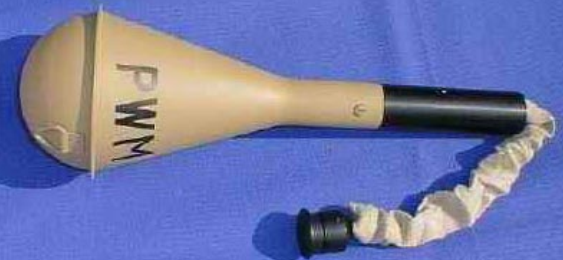
In the modernized PWM Kz grenade, the stabilizer design was changed. Now stabilization was provided with a canvas ribbon, which was pulled out of the handle when throwing. At the same time, the length of the grenade decreased from 530 to 330 mm, and the mass became smaller by 400 g. Due to the reduction in weight and dimensions, the throwing distance increased by about 5 m. In general, PWM Kz was a fairly successful anti-tank ammunition that guarantees the possibility of penetration of all existing armor At that time, serial tanks. This is confirmed by the fact that on the basis of PWM Kz in the USSR in the second half of 1943, the RPG-6 anti-tank grenade was quickly created, which, like PWM Kz, was used until the end of hostilities.
Hand-made anti-tank grenades and cumulative magnetic mines are widespread in the armed forces of Nazi Germany. But at the same time, the German command was well aware of the risk associated with the use of anti-tank "weapons last chance "and sought to equip the infantry with anti-tank weapons, which minimized the risk of personnel damage by shrapnel and a shock wave and there was no need to leave the shelter.
From 1939, the German infantry had an 30-mm Gewehr Panzergranate 30 cumulative rifle grenade (G.Pzgr.30) in the anti-tank arsenal of German infantry. A grenade was shot from a mortar mounted on the muzzle of a standard 7,92-mm Mauser 98k carbine using an idle cartridge with smokeless powder. The maximum range of the shot at an elevation angle of 45 ° exceeded 200 m. Sighting - no more than 40 m.

To stabilize the grenade in flight, in its tail part there was a belt with ready-made cuts, which coincided with the rifled part of the mortar. The head of the grenade was made of tin, and the tail was made of soft aluminum alloy. In the head part there was a cumulative funnel and a trotyl charge with a mass of 32 g, and in the back part - a detonator cap and a bottom fuse. Grenades, along with the expelling cartridges, were delivered to the troops in final form, in cases of pressed cardboard, saturated with paraffin.
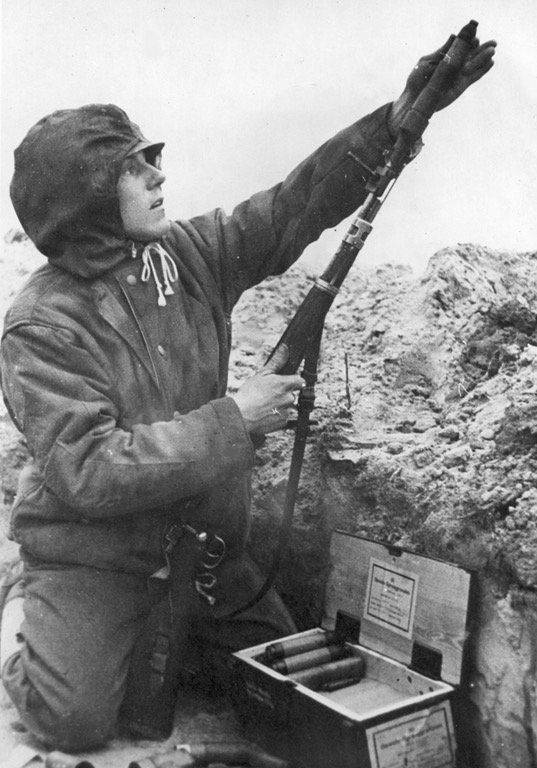
A cumulative G.Pzgr.30 grenade weighing about 250 g along the normal could penetrate 30 mm armor, which made it possible to fight only with light tanks and armored cars. Therefore, in the 1942, the “big” Grosse Gewehrpanzergranate (gr. G. Pzgr.) Rifle grenade with over-caliber warhead entered service. As an expelling charge, a reinforced cartridge with a sleeve with an elongated Dultz and a wooden bullet was used, which, when fired, gave the grenade an additional impetus. At the same time, the recoil was significantly higher, and the shooter's shoulder without the risk of injury sustained no more than 2-3 shots in a row.

The mass of the grenade increased to 380 g, while its body contained 120 g of TNT-hexogen alloy in the proportion of 50 / 50. The declared armor penetration was 70 mm, and the maximum range of a shot from a rifle grenade launcher was 125 m.
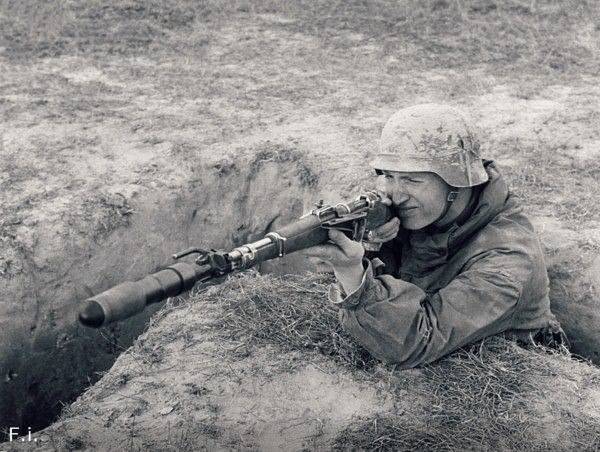
Soon after the appearance of gr. G. Pzgr entered into service with a grenade with a reinforced tail section, intended for shooting from a GzB-39 grenade launcher, which was created on the basis of the PzB-39 anti-tank gun. When reworking into a grenade launcher, the PTR barrel was shortened, a muzzle attachment for shooting rifle grenades and new aiming devices were mounted on it. Like the anti-tank rifle, the PzB-39, the GzB-39 grenade launcher had a bipod folded in the stowed position and a metal butt turning down and forward. For carrying the grenade launcher used mounted on the weapon handle.
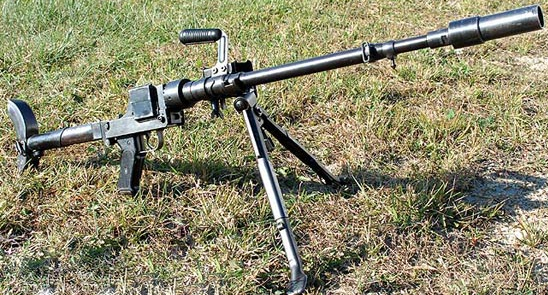
Due to greater strength and better stability, the accuracy of firing from a grenade launcher was higher than that of rifle mortars. Effective fire on mobile targets was possible at a distance of up to 75 m, and for fixed targets - up to 125 m. The initial speed of the grenade is 65 m / s.
Although armor penetration grenade gr. G. Pzgr theoretically allowed to fight with medium tanks T-34, its striking effect in case of penetration of armor was small. At the beginning of the 1943 of the year, a large 46-mm Gewehrpanpangranate 46 (G. Pzgr. 46) improved grip 155 rifle armor-piercing grenade was developed on the basis of the Grosse Gewehrpanzergranate grenade. Due to the increase in the mass of explosive in the cumulative warhead to 46 g, armor penetration G. Pzgr. 80 is 61 mm. However, this was not enough for the Germans and soon the Gewehrpanzergranate 61 grenade (G. Pzgr. 61), which had a warhead length and diameter, was put into service. The mass of 520-mm grenades amounted to 200 g, and its warhead contained an explosive charge of 110 g, which made it possible to pierce an armor plate at XNUMX mm at right angles.
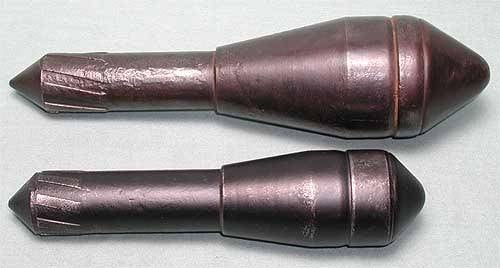
Below - Gewehrpanzergranate 46 rifle grenade. Top - Gewehrpanzergranate 61.
Shooting with new grenades could have been carried out from a rifle mortar mounted on the muzzle of a rifle, but in practice it was difficult to make more than one shot with an emphasis on the shoulder. In this regard, the rifle butt was recommended to rest against the wall of the trench or into the ground, but at the same time shooting accuracy was reduced, and it was almost impossible to hit the moving target. For this reason, G. Pzgr grenades. 46 and G. Pzgr. 61 was mainly used to fire a GzB-39 grenade launcher. According to the reference data, the maximum range of firing from a grenade launcher was 150 m, which, apparently, was made possible by the use of a reinforced expelling cartridge. Before the advent of reactive anti-tank grenade launchers, the GzB-39 remained the most powerful and long-range German infantry anti-tank weapon used in the platoon-company link.
In 1940, the Luftwaffe parachute units adopted the 61-mm rifle grenade Gewehrgranate zur Panzerbekämpfung 40 or GG / P-40 (German. Anti-tank rifle grenade).

The GG / P-40 grenade with the help of a blank cartridge and a muzzle attachment equipped with a grenade launcher, could be fired not only from Mauser 98k carbines, but also from FG-42 automatic rifles. The initial speed of the grenade was 55 m / s. Stabilization in flight was carried out by six-blade tail at the end of the tail section, where the inertial fuze was also located.
A gun-shaped cumulative grenade, weighing 550 g, with an improved warhead equipped with a hexogen charge with a mass of 175 g, provided armor-penetrating capability up to 70 mm. The maximum firing range was 275 m, sighting - 70 m. In addition to the possibility of hitting armored targets, this ammunition had a good fragmentation effect. Although the GG / P-40 rifle grenade at the time of its appearance had good combat characteristics, relatively high reliability, simple design and was inexpensive to manufacture, it did not receive much attention during the initial period of the war due to the contradictions between the Wehrmacht command and the Luftwaffe. After 1942, due to the increased security of the tanks, it was considered obsolete.
In addition to rifle grenades, pistol-based cumulative grenades were used to fire at armored vehicles. Grenades were shot from a standard 26-mm rocket launcher with a smooth barrel or from the Kampfpistole and Sturmpistole grenade launchers, which were created on the basis of single-shot signal pistols with a broken barrel and a hammer-type percussion mechanism. Initially, 26-mm signal pistols by Walter, designed by Walter, were adapted for firing fragmentation and cumulative grenades. 1928 or arr. 1934 of the year.
The 326 H / LP shot, created on the basis of the 326 LP fragmentation grenade, was a feathered cumulative projectile with a contact fuse connected to an aluminum sleeve in which there was a projectile charge.

Although the firing range exceeded 250 m, effective fire with a cumulative grenade was possible at a distance of no more than 50 m. Due to the small caliber of a cumulative grenade, it contained only 15 g of explosive, and the armor penetration did not exceed 20 mm.
Due to the low armor penetration when hit by a “pistol” cumulative grenade, it was often not possible to stop even light tanks with anti-bullet armor. In this regard, based on 26-mm signal pistols, a Kampfpistole grenade launcher with a rifled barrel was created for shooting over-caliber grenades, at the head of which it was possible to place a larger explosive charge. On the left side of the gun body was attached a new graduated sight and spirit level. At the same time, the rifled barrel did not allow the use of either the 326 LP and 326 H / LP pistol grenades, nor the signal and lighting cartridges adopted for 26-mm rocket launchers.

The 61-mm Panzerwnrfkorper 42 LP grenade (PWK 42 LP) had a mass of 600 g and consisted of an over-caliber head part and a rod with ready grooves. The cumulative warhead contained 185 g of the alloy of trotyl with RDX. Its armor penetration was 80 mm, but the effective firing range was no more than 50 m.
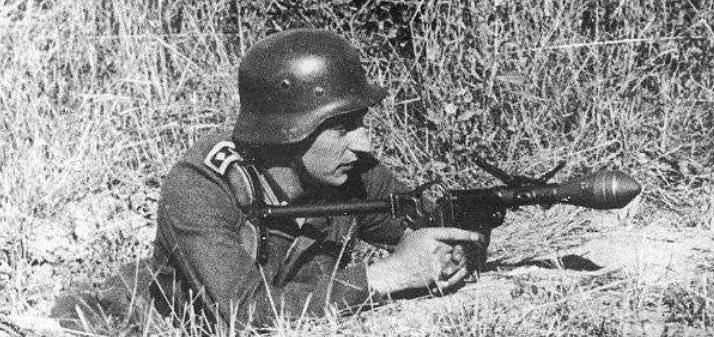
German infantry pistol grenade Sturmpistole charged cumulative grenade PWK 42 LP
Due to the large mass of the projectile and, accordingly, increased recoil, the Sturmpistole “pistol” grenade launcher, which was put into service at the beginning of 1943, used shoulder supports, and the shooting accuracy was improved by introducing a folding sight calibrated at a distance of 200 m. Einstecklauf was able to shoot grenades with ready-made grooves in the tail section, and after its removal it could be fired with old smooth bore ammunition used in signal pistols. Based on the experience of combat use, in the second half of 1943, the Sturmpistole grenade launcher was upgraded, while the barrel length was increased to 180 mm. With a new barrel and an installed butt, its length was 585 mm, and the weight - 2,45 kg. In total, before the start of 1944, the Carl Walther and ERMA firms produced about 25 000 grenade launchers Sturmpistole and 400 000 pcs. loose liner trunks for converting signal pistols into grenade launchers.
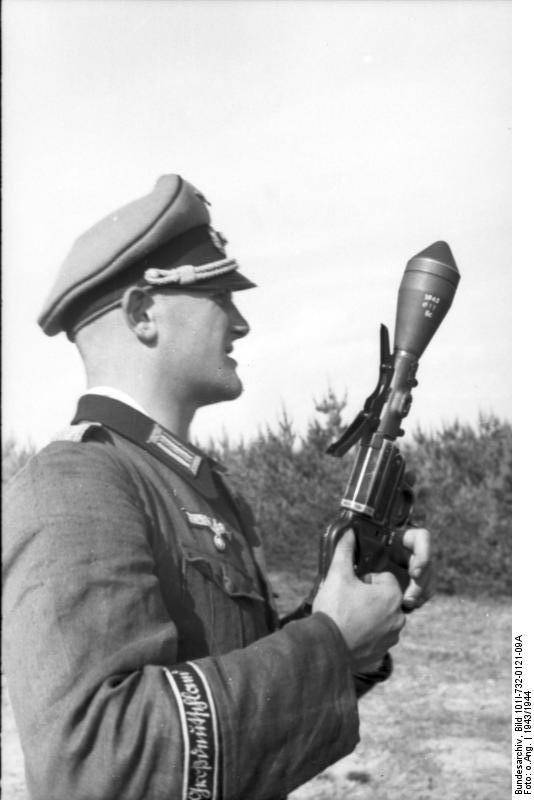
However, grenade launchers, converted from signal pistols, did not greatly enhance the capabilities of the German infantry in the fight against tanks. Since the range of the aimed shot from the “pistol” grenade launcher was small, and the combat rate of fire did not exceed 3 rounds per minute, the infantryman, as a rule, did not have time to make more than one round on the approaching tank. In addition, at a large angle of meeting with the frontal armor of the thirty-four, the inertial fuse located in the tail of the grenade did not always work correctly, and the explosion often occurred when the charge position was unfavorable for penetrating the armor. The same was true of cumulative rifle grenades, which, moreover, were not popular due to baggy application. For firing from a rifle grenade launcher, an infantryman needed to attach a mortar, put a grenade into it, load a rifle with a special expelling cartridge, and only after that aim and fire a shot. And all this is done in a stressful situation, under enemy fire, seeing the approaching Soviet tanks. It can be stated with complete confidence that until November 1943, when the first samples of rocket launchers appeared on the Eastern Front, the German infantry had no weapons to effectively deal with Soviet tanks. But the talk about the German jet disposable and reusable grenade launchers will go in the next part of the review.
To be continued ...
Based on:
http://weaponland.ru/board/
https://ww2aircraft.net/forum/threads/anti-tank-weapons.590/page-3
http://www.lonesentry.com/articles/ttt07/hafthohlladung.html
https://airsoft.ua/group.php?gmid=8906&do=discuss
http://wwii.space/granatyi-germaniya/
http://leuchtpistole.free.fr/Sommaire/En_Modele34.html
http://spec-naz.org/articles/oruzhie_i_boevaya_tekhnika/rifle_anti_tank_grenades_during_world_war_ii/
http://www.inert-ord.net/ger03a/gerrg2/ggp40/index.html
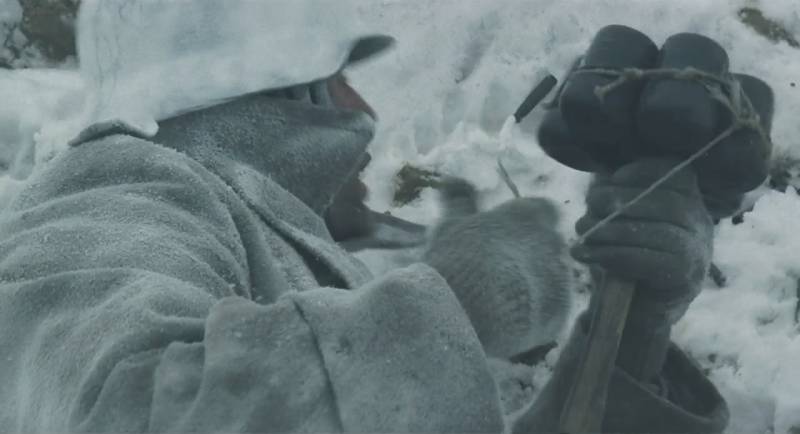
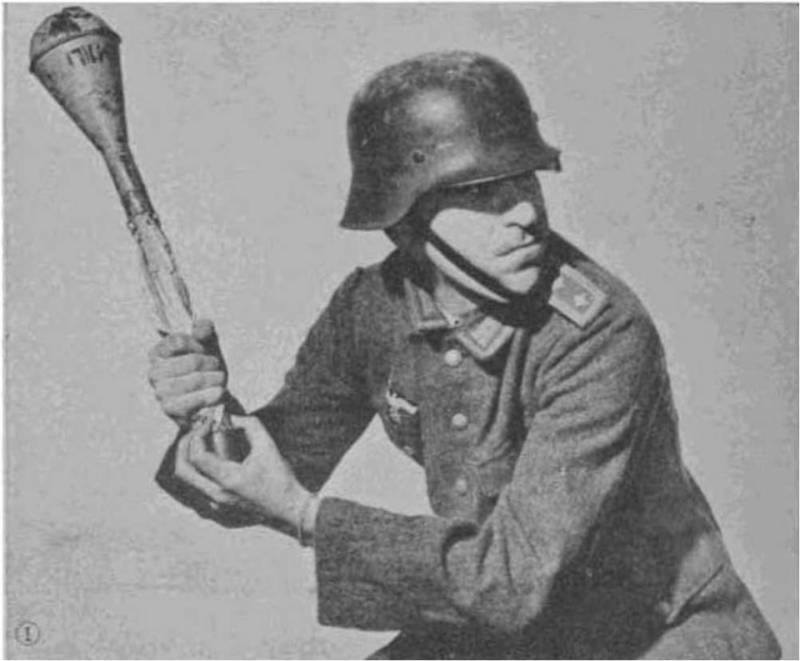

Information